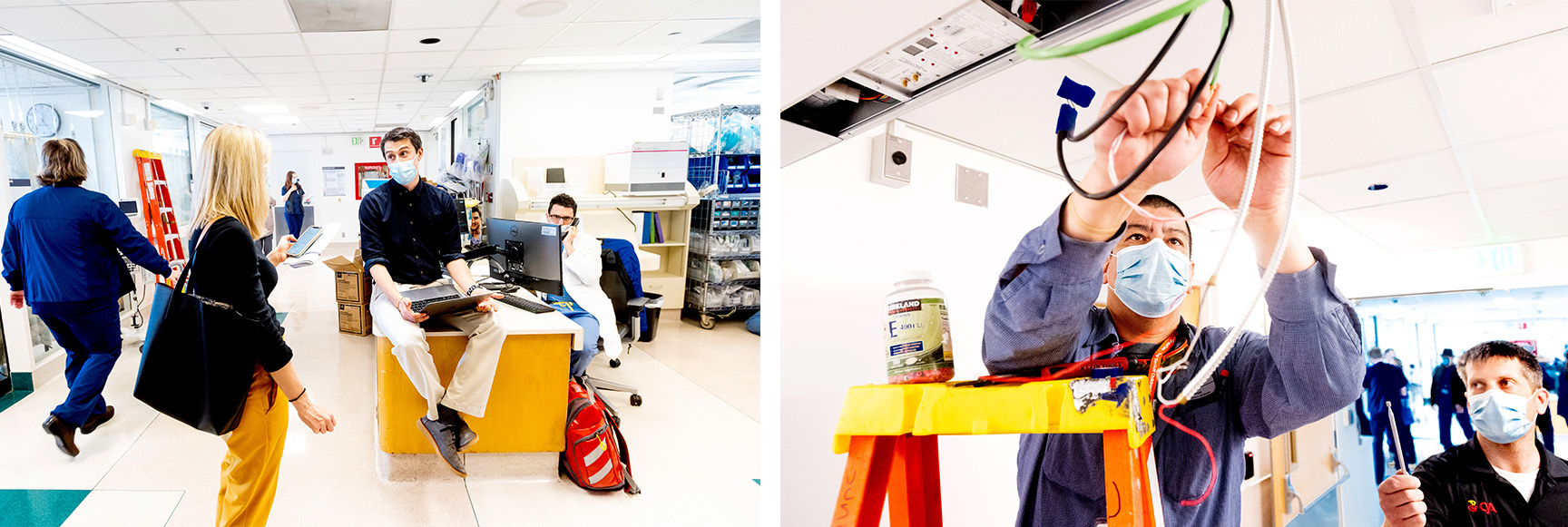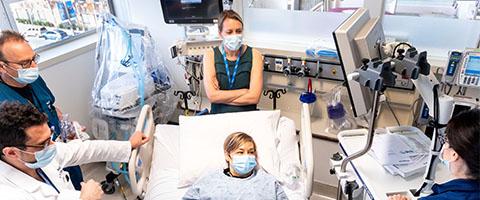The last five years have seen a major expansion of UCSF Health, which has created numerous opportunities for the UCSF Department of Anesthesia and Perioperative Care to deliver care at facilities in Marin County, as well as the cities of Fremont, San Mateo and Berkeley. The department has also played an important role in growth at UCSF’s San Francisco facilities, with UCSF Medical Center at Mount Zion the most prominent recent example.
COVID-19 Pandemic Spurs Change
In April 2020, UCSF Medical Center at Mount Zion opened a new, 53-bed respiratory isolation unit, with the expectation that it would serve an expected surge of patients with COVID-19. The facility – which in 2015 converted from an inpatient hospital to an ambulatory care and 23-hour stay facility – undertook a 43-day sprint to qualify, once again, as a hospital licensed for overnight stays. Among the renovations: a revamped ventilation system, technology to accommodate ventilators for ICU beds and video calls from each room, the conversion of double-occupancy rooms into single units, a modern nursing call system, and a reestablished food service.
“Then, when the surges were not as overwhelming as we all anticipated, we began to think about how best to make use of this space now that we had more inpatient capacity,” says anesthesiologist Christina Inglis-Arkell, MD, anesthesia director and medical director of the surgery center at Mount Zion. “With UCSF Health overflowing with patient demand in other locations, we realized this was an opportunity to ease loads across the health system.”
Building an Orthopedics Hub at Mount Zion
Largely because UCSF Mount Zion does not have an emergency department, the team there focused on creating a low and moderate acuity surgical hospital.
“In a collaborative process, with others at UCSF Health, we settled on moving a key set of orthopedic surgeries here, primarily arthroplasty and orthopedic trauma,” says Inglis-Arkell, who is part of a leadership triad that includes orthopedic surgeon Ben Ma, MD, and RN Lina Bandera. “We also perform other short stay surgeries here, including ophthalmologic, endocrine and gynecologic surgeries.”
The orthopedic surgery service began in February 2021, with most arthroplasty procedures that surgeons had previously done elsewhere moving to Mount Zion. Inglis-Arkell notes that UCSF Health established a pathway to directly transfer appropriate patients needing orthopedic surgery from the emergency department at UCSF Helen Diller Medical Center at Parnassus Heights to Mount Zion.
In addition, to meet the needs of patients undergoing joint replacements, the anesthesia team created a new regional pain service at the facility. “And because this is now where the vast majority of nerve blocks are done, residents now do their regional rotations here,” says Inglis-Arkell.
A Long History of Successful Change
“Mount Zion is the master of transitions,” says Inglis-Arkell. “We’ve evolved so much, in so many ways over the last few years, we were well-suited to continuing that process. We have a unique culture, very unified and family-like – with a can-do spirit.”
She says that culture is important given the many demands of returning to overnight stays. Nurses who transferred from Parnassus had to acclimate to a new clinical setting. The facility had to make room for equipment necessary for the added surgeries. Workflows and scheduling had to adapt. Added complication risks and complexity often accompany surgeries that require overnight stays. All of that adaptation had to take place in the middle of a pandemic.
“Because of the speed and breadth of these changes, our leadership triad has had to be very proactive about communication and team building,” says Inglis-Arkell. “We’ve held numerous recognitions and appreciations to create community. We also meet monthly with surgical leads, the local OR committee, and all subspecialties, to discuss problems and challenges.”
Given the new demands, Inglis-Arkell is grateful for the working relationship that she, Ma and Bandera have built. She says, “We’ve naturally fallen into our roles, which is not surprising because, as I said, the culture here is one of a small community-focused team with shared goals.”
It also helps that the collaborative approach extends across all of UCSF Health. The Department of Orthopaedic Surgery seized the opportunity to build a center of excellence from scratch at Mount Zion, while the transfer of surgery cases there freed space for other procedures at UCSF’s other facilities.
Inglis-Arkell believes all of these factors contributed to the successful transition, building on a tradition of change that has been in place since Mount Zion’s birth in 1877. She says, “People here understand Mount Zion is an ever-evolving institution. This is just the latest evolution.”

Article written by Andrew Schwartz
